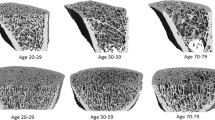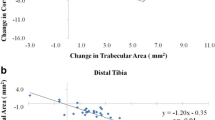Abstract:
The current study was designed to investigate the rate of bone loss in distal radius and its association with baseline volumetric bone mineral density (BMD) and years since menopause (YSM) in peri- and postmenopausal women using precise and multislice peripheral quantitative computed tomography (pQCT; Densiscan 2000). Two hundred and five healthy Hong Kong Chinese perimenopausal (n = 26) and postmenopausal (n = 179) women within 10 years of the onset of menopause were recruited. Anthropometric parameters and menstrual status were also measured. The linear regression model derived from the baseline volumetric BMD revealed a significant and slightly better correlation with YSM than age, with a YSM-related annual decline of 2.56%, 1.82% and 0.65% in trabecular BMD (tBMD), integral BMD (iBMD) and cortical BMD (cBMD), respectively. Follow-up measurements after a time interval of 12 months showed that the rate of bone loss was higher than the annual decline in BMD calculated from the baseline BMD, with decreases of 2.89%, 2.16% 0.91% in tBMD, iBMD and cBMD, respectively. Baseline BMD was associated with age or YSM (r ranges from −0.283 to −0.502; p<0.001 in all cases), but no relationship was found between annual rate of bone loss and age or YSM. The rate of bone loss did not correlate with baseline volumetric BMD values or YSM after dividing the subjects into fast bone losers (with annual tBMD loss ≥3%), normal bone losers (with annual tBMD loss ≥ 1% but <3%) or slow bone losers (with annual tBMD loss <1%). The rate of bone loss was greater in both trabecular and cortical bone of postmenopausal women within the first 3 menopausal years but was only significant in the iBMD as compared with perimenopausal and postmenopausal women over 7 years after onset of menopause. The percentage distribution of slow and fast bone losers was not found to be associated with YSM. As a total of only 4 fracture cases were documented, the study could not provide conclusive information on whether perimenopausal and early postmenopausal baseline volumetric BMD or rate of bone loss determines the development of osteoporosis or fracture occurrence.
Similar content being viewed by others
Author information
Authors and Affiliations
Additional information
Received: 12 November 2001 / Accepted: 18 July 2002
Rights and permissions
About this article
Cite this article
Qin, L., Au, S., Leung, P. et al. Baseline BMD and Bone Loss at Distal Radius Measured by Peripheral Quantitative Computed Tomography in Peri- and Postmenopausal Hong Kong Chinese Women . Osteoporos Int 13, 962–970 (2002). https://doi.org/10.1007/s001980200134
Issue Date:
DOI: https://doi.org/10.1007/s001980200134




